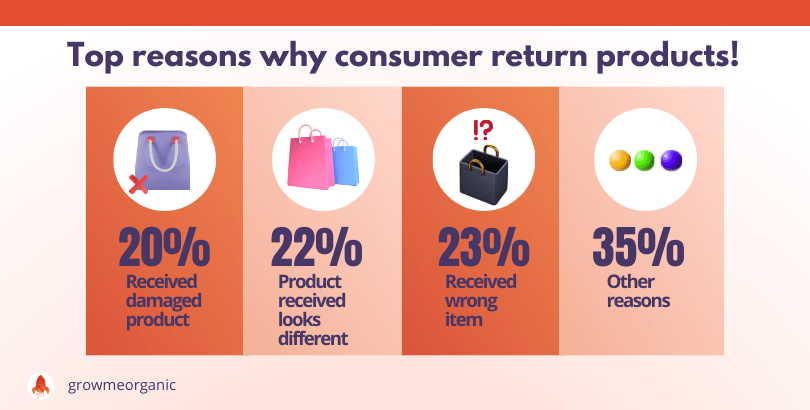Almost all e-commerce merchants hope to avoid product returns when they can, but the reality is that in 2020 alone, there was a total of $428 billion in returns.
Merchants handle product returns differently. Some have strict policies that make returning unwanted items difficult. Others try their best to resolve the issue before accepting returns.
The return process does not need to be less consumer-friendly. Making it more difficult for leads to return a product will just drive them away before they even make the purchase. Furthermore, customers who are unable to return unwanted items will be far less likely to shop with you again in the future, and they could even leave negative reviews that discourage others from buying from you.
Making the return process transparent and simpler is the focus of our guide to product returns. Rather than trying to discourage customers from returning, try to make a positive impression and keep them interested in placing another order later.
So, let’s talk about what digital marketers need to know in 2022 about product returns.
What Are the Reasons Customers Return Products?
Product returns can be attributed to many different factors, so there’s no one reason consumers send back products. Merchants can categorize returns as controlled or uncontrolled.
You must determine a new packaging method if you are frequently receiving returns for products damaged during shipping. Controllable returns include items returned for reasons that can be traced back to the seller. For example, damaged goods are returned during shipping.
Uncontrollable returns, on the other hand, are beyond the control of merchants. This is particularly true for brands that sell clothing and other items that are viewed as attractive.
As the product is shown online, customers might feel differently about the product as it is delivered to them. There is no way around it. This percentage of return is simply a part of doing business.
Products are returned for a variety of reasons that vary between industries and even from one merchant to another. Optimizing your approach to product returns begins with understanding why your customers send items back.
Process optimization for returns:
One of the most common mistakes digital marketers made in 2021 is adding unnecessary complications to the return process. By increasing the difficulty of returning products, you will only give them a negative impression and reduce the likelihood of a repeat purchase.
To optimize the return process, friction must be removed. You should make it as easy and fast as possible for customers to get a refund or exchange. It is normal for consumers to buy from Amazon and other giants of e-commerce. Even small retailers need to provide a seamless return experience.
Customers will find it easier to package and label their returns if they can print shipping labels. Implementing a QR code generator for return labels can further streamline this process, allowing customers to simply scan the code with their smartphones to initiate returns rather than manually writing information.
In addition to being more reliable, automated labels eliminate the possibility of errors in addresses and other problems associated with handwritten ones.
Returning products both online and in-store can be challenging for merchants. When buying an item online and returning it to a physical store, customers appreciate the mix-and-match option.
Bringing online customers to your brick-and-mortar store lets them see your products in person if you have a brick-and-mortar store. In this way, the customer can replace the item they’re returning with another item.
How to create a return policy
Setting a clear return policy will help you set expectations with your customers. When visitors receive an order, a clear policy informs them when they can begin the return process.
In addition to these, it should outline other important restrictions and rules. You should also know who pays for return shipping and what items may be returned or exchanged.
Customers aren’t likely to search for your return policy on their own. Be sure visitors encounter the policy when creating an order at least once to minimize controllable returns.
In addition, you can provide policy details on product pages, emails, and again during checkout.
Fast Return Processing
Customer service teams are placed under additional pressure if return processing takes too long. This will negatively impact the customer experience. An irate customer can even stop looking at the updates and important emails from your company. Your refund or exchange should be processed within one or two business days after receiving the item.
Your return policy should specify the standard turnaround time for processing returns. If you don’t give that information upfront, your support staff will end up answering daily calls from customers who want to know when their refunds will arrive.
Tracking orders is expected by consumers, and brands should also offer tracking and proactive updates for returns. The status of returns should be visible to customers who send products back.
Payment Refunds
A merchant must refund the cost of returned products to the original payment method when customers return products. Ecommerce companies do this routinely. Customers should always be provided with this option.
As an alternative to standard refunds, you can also provide store credit. To entice your customers to choose store credit, you can offer small perks. Restocking fees could be waived or loyalty program points awarded.
Merchants and customers both benefit from credit-it prevents customers from taking their money and spending it elsewhere.
Reviewing Return Data
A valuable resource is product return data. Return data provides insight into buyer behaviour and trends. Although some returns are unavoidable, by monitoring your return data, you can eliminate returns, all while optimizing customer experience.
Merchants that sell clothing are one example of how these insights can be applied. Look for ways to help customers identify their right size more frequently if they are constantly exchanging clothes for another size.
Likewise, more frequently returned products may have defects or fail to meet buyer expectations. As a result, you can reflect on which products are selling or rather, why some aren’t.
As you address more and more common complaints, you should notice that returns will gradually decrease. As part of your return process, ask customers for feedback. With this insight, you can address the issue and minimize returns in the future.
Reconnecting after a return
Leads that return do not mean that they will not return in the future. There is no doubt that selling to an existing customer is much cheaper than finding a new one. Your sales funnel should be designed with audience retention in mind.
Ask for feedback after each return by sending a quick email. Offer cross-selling options as well. Re-engagement emails should be easy to set up based on each user’s purchase history in your email marketing platform.
About Post Author
Anant Gupta
Growth Hacker, Marketing Automation Enthusiast & Founder of GrowMeOrganic







